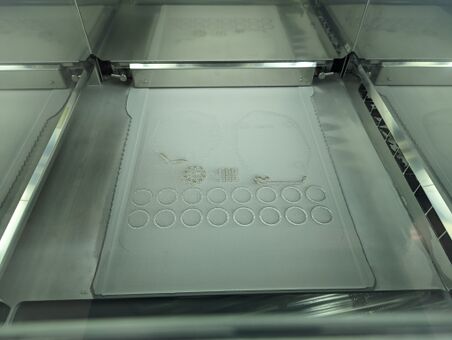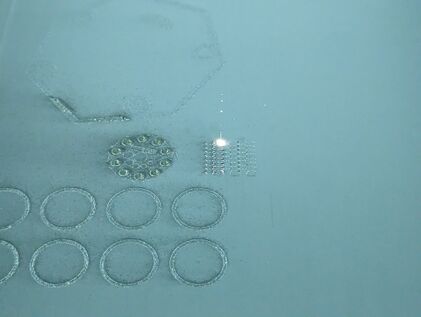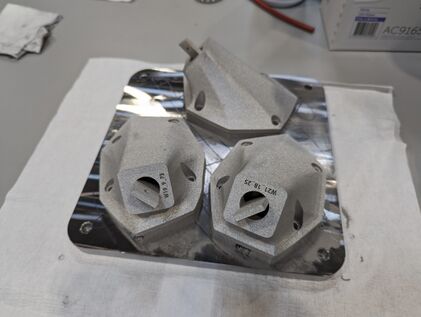Powder Bed Fusion: Difference between revisions
No edit summary |
No edit summary |
||
| Line 1: | Line 1: | ||
== Process description == | == Process description == | ||
[[File:PXL 20230828 231728663.jpg|right|frameless| | [[File:PXL 20230828 231728663.jpg|right|frameless|452x452px]] | ||
Although it can use a number of different materials the main use of powder bed fusion is being a convenient way to print metal parts. spreading a layer a powdered material over the entire print surface, and then selectively melting the sections that will be in the final part. another layer is then added on top of the last repeating the process until the part is completed. after the part is thoroughly cleaned and scrubbed to remove exes powder. | Although it can use a number of different materials the main use of powder bed fusion is being a convenient way to print metal parts. spreading a layer a powdered material over the entire print surface, and then selectively melting the sections that will be in the final part. another layer is then added on top of the last repeating the process until the part is completed. after the part is thoroughly cleaned and scrubbed to remove exes powder. | ||
==Strengths & Weaknesses== | |||
The benefits of Powder Bed Fusion: | |||
*'''built in support system:''' The excess powder supports the print so there's no need to add printed supports | |||
* '''in house metal components''': PBF can be small enough to fit into a variety of spaces. this allows for organizations to create metal prototypes | |||
The drawbacks of Powder Bed Fusion: | |||
* '''High energy use:''' melting metal takes much more energy then melting thermoplastics. | *'''High energy use:''' melting metal takes much more energy then melting thermoplastics. | ||
* '''Surface finish:''' Powder bed fusion generally has a rough surface finish that mimics the grain size of the material. | * '''Surface finish:''' Powder bed fusion generally has a rough surface finish that mimics the grain size of the material. | ||
* '''material properties:''' the way that parts are formed creates a weaker grain structure then a cast part made out of the same material. | * '''material properties:''' the way that parts are formed creates a weaker grain structure then a cast part made out of the same material. | ||
[[File:PXL 20230828 232002915.jpg|right|frameless|421x421px]] | |||
[[File:PXL 20230817 210159504.jpg|right|frameless|421x421px]] | |||
== Printer properties == | |||
{| class="wikitable" | {| class="wikitable" | ||
! | ! | ||
Revision as of 13:35, 14 September 2023
Process description
Although it can use a number of different materials the main use of powder bed fusion is being a convenient way to print metal parts. spreading a layer a powdered material over the entire print surface, and then selectively melting the sections that will be in the final part. another layer is then added on top of the last repeating the process until the part is completed. after the part is thoroughly cleaned and scrubbed to remove exes powder.
Strengths & Weaknesses
The benefits of Powder Bed Fusion:
- built in support system: The excess powder supports the print so there's no need to add printed supports
- in house metal components: PBF can be small enough to fit into a variety of spaces. this allows for organizations to create metal prototypes
The drawbacks of Powder Bed Fusion:
- High energy use: melting metal takes much more energy then melting thermoplastics.
- Surface finish: Powder bed fusion generally has a rough surface finish that mimics the grain size of the material.
- material properties: the way that parts are formed creates a weaker grain structure then a cast part made out of the same material.
Printer properties
| Low | High | |
|---|---|---|
| volume X/Y/Z (mm) | 250/250/325 | 800/400/500 |
| resolution (mm) | .06 | .1 |
| layer height (um) | 20 | 120 |
| price ($) | 1600000 |
Technologies
There are a number of specific technologies that can vastly change to capabilities of a printer.
Selective laser sintering (SLS) this is the general term for most non metal powder bed fusion technologies. the title refers to the fact that the heat source only adds enough energy to fuse the powder instead of fully melting it. this gives an alternative for materials that material extrusion might struggle to print such as nylon or softer thermoplastics.
selective laser melting (SLM) in contrast to sls, slm refers to most processes of metal powder bed fusion. the energy added completely melted making the internal structure more homogenous. this technique allows for fully metal prototypes relatively easily. these parts will require supports to prevent warping due to temperature changes


